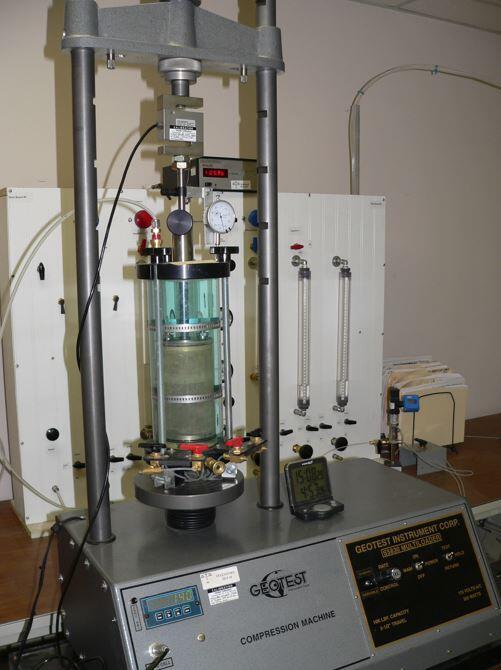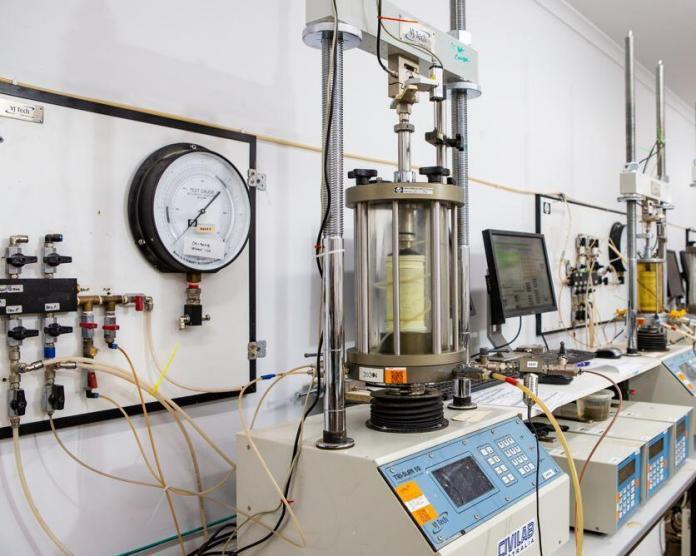The internal resistance that the soil mass can provide per unit area to withstand failure and sliding along any plane within it is known as the shear strength of soil. Shear strength can be measured in a lab, out in the field, or perhaps both.
Triaxial compression tests, unconfined compression testing, and direct shear box tests are just a few of the tests that may be used in the lab. In situ tests are typically performed for both design purposes and to evaluate the reliability of laboratory experiments. Field vane, standard penetration test (SPT), and cone penetration test (CPT) are some of the available in-situ testing (CPT).
For a variety of issues, including the design of foundations, slope stability, retaining walls, and dam embankments in civil engineering applications, the shear strength of soil is necessary. An engineer’s responsibility to ensure that the structure is secure against shear failure in the soil that supports it and does not experience excessive settlement is very critical.
It is very important to understand the soil’s behaviour under stress and strain as well as its deformation and shear strength. When dealing with clay soil, which is renowned for being highly malleable and having poor shear strength, these concerns become more problematic and difficult.
Engineers have generally spent a lot of time measuring the shear strength of soils, but not as much time figuring out the fundamental elements that affect shear strength. The goal of this article is to learn more about the shear strength of soils and how the fundamental variables affect the shear strength of clay soils. The present analysis has focused primarily on the sources of shear strength in cohesive soils since these causes are less well understood than the causes of strength in cohesionless soils.
Components of shear strength in soils
The angle of internal friction (ϕ) and cohesion (c) are the two important parameters that determine the shear strength of soils. The soil’s maximum capacity to withstand shear stress under a given load is determined by the two factors. The cohesion measures the ionic attraction and chemical cementation between soil particles, and the angle of internal friction shows the amount of friction and interlocking that exists among soil particles.
By carrying out the necessary shear strength tests, it is possible to determine both of these characteristics in a laboratory. In-situ soil shear strength parameters can only be estimated using a limited number of field test procedures. While forces of attraction between clay-sized particle particles affect the strength of cohesive soils, friction between the particles is the primary driver of strength in coarse soils. Due to their ability to give soils flexibility and cohesion, it is convenient to think of such particles as plastic particles.

Using the cohesion and angle of internal friction, the shear strength of a soil mass can be calculated using the Mohr-Coulomb shear strength equation as follows;
τ = σ tan(ϕ) + c ——— (1)

The angle of internal friction
The friction angle for a particular soil is the angle on the graph (Mohr’s Circle) where shear failure takes place. Soil friction angle is typically indicated by the symbol “ϕ“. Internal friction is typically understood as the grading-based resistance that two planes experience when they move in opposition to one another.
If the soil specimen is given time to solidify, friction increases as the typical load increases. Sand-containing gravels usually have a friction angle of 34° to 48°, loose to dense sand has a friction angle of 30° to 45°, silts have a friction angle of 26° to 35°, and clay has a friction angle of about 20°.
All well-graded soils have a high angle of internal friction values. Particle size, compaction force, and applied stress level are factors that affect friction angle. Although certain research has made it clearer by stating that the friction angle increases as the maximum particle size increases, friction angle does increase with an increase in particle size. With an increase in surface angularity and roughness, friction angle has also been observed to increase.
Cohesion
It is possible to define cohesion as the specific portion of shear strength that results from the forces of attraction that exist between the clay minerals. The ability of soil to act like glue, binding the grains together, is known as cohesion. It is an important element of shear strength, especially for fine-grained soils. The letter “c” is commonly used to indicate soil cohesion. Silt typically has a cohesion value of 75 KPa, but the cohesion of clay can range from 10 to 400 KPa, depending on how stiff the clay is (from soft to high).
An extremely strong cohesion can be produced by naturally occurring minerals that have leached into the soil, such as caliches and salts. The soil grains will tend to fuse together due to heat fusion and sustained overburden pressure, resulting in substantial cohesion.
At the start of the stress condition, cohesion mobilizes and achieves its peak levels around the plastic limit, or at the start of structural collapse. Cohesion increases as one approach the shrinkage limit and diminishes as one approaches the liquid limit. With the exception of clayey soils, where a rise in stress induces an increase in molecular bonds, cohesion often does not increase as stress increases.
Factors affecting the shear strength of soils
Many factors are recognized to have a direct effect on the shear strength of cohesive soils and play a significant role in strength determination. These factors include;
- clay content
- clay mineralogy
- plasticity index
- water content
- dry density, and
- strain rate
A brief review of these factors, as reported by previous investigators is outlined below.
Clay Content
The cohesion and the friction angle are significantly affected by the percentage of clay in the soil mass. The addition of more clay increases the cohesiveness for water contents that are a little above the optimum water content. If the moisture level is considerably higher than the optimum water content, this improvement could not be possible. Increased clay fractions will result in stronger binding forces, which will increase the soil’s strength.
Clay mineralogy and microfabric
The shear strength of cohesive soils is influenced by the environmental conditions as well as the mineral composition of the clay. Clay’s shear strength is decreased by the presence of clay minerals. The weakest and most prone to swelling of the clay minerals is the expansive clay montmorillonite.
In expansive soils, shrinkage and swelling have completely different impacts on the shear strength. Fully inflated clay typically has poor shear strength, whereas dry shrinking clay might have better cohesiveness. The principal stresses of the soil’s shear strength are greatly influenced by the clay minerals.

The amount of kaolinite in the soils is directly related to the primary stress that was measured (σ1). This might be explained by the characteristics of kaolinite particles, which among the clay mineral species under investigation have the biggest grain sizes. The microfabric, or diameter-to-thickness ratio, of the kaolinite particles, is the smallest. As a result, the edge surface of the kaolinite particles is quite large.
The charge is differently distributed in kaolinite, with one basal plane being highly charged and the other uncharged. High major stress resulted from this for both the calcium and sodium types. Intergranular friction is the main cause of kaolinite’s relatively high major stress.
Plasticity Index
The behaviour of cohesive soil is significantly influenced by the plasticity of the soil. Numerous academics are working to understand how plasticity affects the shear strength of cohesive soils. Shear strength decreases as the plasticity index rises. According to research, high plastic clay has stronger binding pressures, which increases the soil’s shear strength. It was found that clay soils with higher calcium carbonate contents have lower plasticity indices and significantly higher shear strengths.
Skempton looked at how plasticity index affected shear strength and proposed a formula that is frequently used to forecast shear strength. Skempton discovered that the plasticity index PI (%) for the vane shear test is a linear function of the undrained shear-strength ratio of properly consolidated clays, as shown in Equation below (1).
Water content
Cohesion typically increases with water content up to the optimum water content, after which it generally decreases with water content. On the other hand, friction reduces as water content rises and eventually stabilizes at a value close to its maximum. As a result, shear strength decreases as water content rises because suction’s contribution to shear strength declines.
According to Lambe and Whitman, the undrained shear strength is independent of a change in total stress unless a change in water content occurs and postulated that the water content is a function of the maximum principle consideration stress alone. Similar studies discovered that a nonlinear function could be used to depict the link between the amount of water present in soils and the undrained shear strength.
In compacted clay soil, the shear strength falls as the water content rises. The shear strength of soil varies exponentially across consistency limits, and the corresponding fitting equation aids in calculating strength at any relevant water content.
With a drop in water content, it is anticipated that the shear strength will rise. This presumption is in line with some observations that clay soils compacted with a moisture content lower than the ideal behave in a coarser manner as a result of aggregation than would be allowed by the grading. Because clay particles aggregate into aggregates with larger effective particle sizes, a fall in water content in clay soils causes a higher friction angle.
Dry Density
The dry density of cohesive soil has a significant impact on its shear strength. Because shear strength increases as dry density increases, a rise in density or a fall in the void ratio will result in an increase in friction angle. With an increase in the soils’ dry density, the primary stress (σ1) increases.
Strain Rate
The testing preparations with relation to drainage conditions and the type of soil tested determine how significantly the shearing rate affects the results. In clays, the strain rate is typically quite low to allow the pore water pressure to dissipate. One test could take several days to complete. However, a more accurate approximation for an undrained specimen can be found in the drained strength measured in a test at a rate of 1.2 to 1.3 mm/min.
With an increase in shear strain rate, undrained shear strength rises. It should be noted, though, that the undrained strength would be underestimated by the quick direct shear testing.










